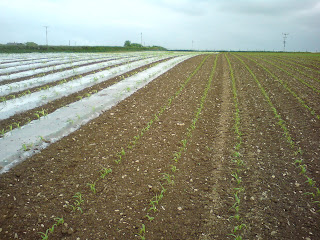Nickerson has been doing this show for a long time and as usual it didn't disappoint as Simon Broddle had spent a lot of time and energy making sure it had plenty for people to look at and discuss. No point in showing things in photo's if you can root around and actually see the practical benefits 'hands on' so to speak.
The one display that got most people talking and thinking was the 'Broadcast vs Drilled' circle. The mix was Blue Circle, a 10 year ley with a good spread of early, intermediates, and late perrenial ryegrasses and a mix of small, medium and large leafed white clovers. The plot was broadcast and drilled (half : half) at the standard 14kgs/ac rate, the drilled piece being drilled with an amenity drill on 2" row spacings. A conventional cereal type drill would have much wider rows and would have accentuated the problems even further.
Visually, the broadcast part looked shorter and there were far fewer heading plants, whilst the drilled part looked more impressive with taller heading varieties. However when you got up close and looked into both swards, the drilled part was much thinner, there was more weed species visible which were growing in the gaps between the drilled rows, the species of grass in these rows were virtually all tetraploid and hybrid species of ryegrass, the clovers were mostly long petiole large leafed, with little of the smaller white clovers surviving. Basically, the drilled lines had squeezed out all the diploid types, along with the medium and small clovers, completely altering the nature of the sward from a longterm ley to a medium term one more suited to cutting than grazing with sheep and cattle. The same thing happens when you plant grass seeds too deep! The broadcast part on the otherhand was thick, like a carpet, had all the species in the mix present and had produced 400kg/ha DryMatter (DM) more than the drilled part. Over a season this would equate to nearly a tonne of DM more for the broadcast part than the drilled portion. This difference is worth the cost of the seed, in the first year alone! Makes you think.....
Click on the pictures to see it in full size, they're not the clearest one I know, but it shows what I have been talking about above.
The upshot of this stand display was one farmer cancelling his newly ordered grass drill which he confessed to buying earlier in the day as 'all the farmers and contractors around us are using these drills now and we thought they looked like there were doing a good job'. Having looked at this demonstration agast at the differences and losses, he cancelled the drill order......
The broadcast piece on the left, drilled to the right of the posts.
The show although suffering with a lack of grass through the drought, was very busy for us, the general consensus from people being it was well worth the effort to get to it. It was amusing to hear that even though there wasn't a lot of grass, they still managed to block the Krone BigX forager, the clip of which can be found here: http://www.youtube.com/watch?v=Bb2FSgt1zOA&feature=feedu













